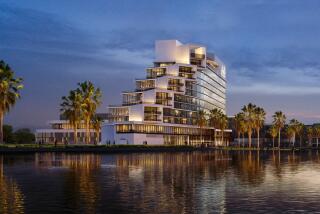Waterfront Hilton Developer Defaults on $57.7-Million Loan; Cutback Seen
- Share via
HUNTINGTON BEACH — Developers of the Waterfront Hilton, a jewel in Huntington Beach’s multimillion-dollar downtown redevelopment, have defaulted on a $57.7-million construction loan and have proposed scaling back additional hotels planned for the coastline project.
Waterfront Construction Co. No. 1, owner and developer of the 12-story hotel along Pacific Coast Highway, said it is negotiating with its lender, Tokyo-based Dai-Ichi Kangyo Bank Ltd., to extend the length of its debt another five years beyond its Jan. 1, 1993, due date. The outlook is clouded because banks have been tight on making new loans to the overbuilt hotel industry.
“We continue to meet with the bank on a weekly basis,” said Steve Bone, president of the hotel and partner in the project with Newport Beach developer Robert Mayer. “There is no money in the world for any commercial refinancing.”
Bank officials refused to comment. The developers have 90 days from the end of the loan term to negotiate a new agreement with the lender or face the foreclosure and sale of the property, according to Alan Zall, a Tustin attorney who specializes in real estate financing issues.
When it opened in 1990, the 300-room complex overlooking the Pacific Ocean was planned as the first of four hotels in the vicinity that would transform the Huntington Beach waterfront into a Miami Beach-like row of luxury resort projects. A shopping plaza and 875 condominiums also were included in the 44-acre project.
“It’s disappointing, with the economy the way it is,” said Barbara Kaiser, deputy city administrator for economic development. “But if they do a foreclosure, we foresee the hotel remaining open. It’s well-managed and has a high occupancy rate. . . . It’s not unusual for hotels, because of the cost of construction, to go through several bankruptcies and then stabilize.”
The Waterfront’s debut came just as a national hotel boom had peaked, and developers found themselves in a market saturated with an overabundance of lavish rooms that became ever more difficult to fill.
Waterfront officials say the hotel has been in the black and is able to rent 70% of its rooms, on average. The hotel also continues its aggressive marketing, most recently attracting the University of Michigan team for its Rose Bowl stay.
“We’re maybe one of the only hotels that is profitable,” Bone said. “We’re well above the Orange County average (for room occupancy),” which was nearly 60% in the first three months of 1992.
But analysts say the Waterfront has fallen victim to lower-than-expected room rates. With other luxury hotels already slashing prices, the Waterfront has had to follow suit. In February, the hotel’s rates will run from $99 to $205, depending on the time of the month and the floor the room is on. Even more, its location is far from a freeway or airport, making it even tougher to attract out-of-town business groups.
“There’s so many choices for a group property,” said Donald Wise, vice president for lodging and hospitality programs at CB Commercial Real Estate in Anaheim. “The list just goes on and on. Rates are the problem, and it’s a market condition.”
For example, even hotels such as the Ritz-Carlton have had to cut rates from $175 a night to as low as $110 to $130 per night, Wise said.
Meanwhile, Waterfront Properties and the Robert Mayer Corp. are considering a scaled-back expansion. Under the original proposal, the second hotel to be built would have been a 500-room, 20-story hotel and conference center. A 250-room hotel and a 400-room hotel would have been built farther south on Pacific Coast Highway and north of Beach Boulevard.
Instead, Bone said, the hotels probably will have fewer rooms and be two or three stories. He said specific numbers of rooms were still being discussed.
“They would still be very much luxury hotels,” he said. “Think more of it as a product that is built in Santa Barbara.”
The residential phase of the project--the part that would reap the greatest profit for the developers--would include 875 condominiums on the east side of Walnut Avenue between Huntington Street and Beach Boulevard. But that phase could only be built after the construction of an additional hotel, Kaiser said.
The developers recently proposed that the city finance the construction of a conference center next to the Hilton that would include a 12,000-square-foot ballroom and another 8,000-square-foot meeting space. But city officials rejected the idea because of doubts they could recover the $7-million to $8-million cost of construction on income from renting the space, Kaiser said.
More to Read
Sign up for Essential California
The most important California stories and recommendations in your inbox every morning.
You may occasionally receive promotional content from the Los Angeles Times.






